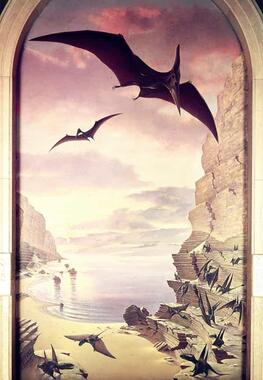Mary Anning, Fossil Fanatic
While Mary Anning was growing up in England in the 1800s, her father taught her how to collect fossils. The cliffs near her home were loaded with spectacular specimens. When her father died, Mary and her mother began a fossil collecting business. At about age 11, Mary and her brother found the first complete Ichthyosaurus fossil. She also discovered a Plesiosaurus, Pteradactylus, and the fossil fish called Squaloraja. When Mary found a good fossil, she often left her dog behind to mark the spot while she fetched others to help her dig it out. As an adult, Mary was finally recognized as a great fossil collector by the scientific community of London.
Definition: the process when organic material (bones, shells, leaves) is turned into stone
Name Origin: from the Latin word fossilis, which translates into "something dug up"
Researcher: German physician Georgius Agricola first used the term "fossil" in his book, The Nature of Fossils, published in 1546
Significance: Fossils are the key to understanding life in the past.


What is this?
butterscotch candy
amber
spider Jell-O
Correct!
Amber is fossilized tree sap. Sometimes animals like insects or lizards get stuck in this sticky liquid. Their remains are found in the fossilized sap.

This is a picture of a coprolite, which is:
a Triassic sea creature
a yummy dessert
fossilized poop
Correct!
Coprolites are fossilized poop. By studying them, we can learn about an animal's habitat and diet when it was alive.
Most fossils are found in metamorphic rock.
Fiction
The best place to find fossils is sedimentary rock. Fossils form when living things become covered with layers of sediment.




 Biodiversity
Biodiversity
 Brain
Brain
 Genetics
Genetics
 Marine BiOLogy
Marine BiOLogy
 MicrobiOLogy
MicrobiOLogy
 PaleontOLogy
PaleontOLogy
 ZoOLogy
ZoOLogy
 AnthropOLogy
AnthropOLogy
 ArchaeOLogy
ArchaeOLogy
 Astronomy
Astronomy
 Climate Change
Climate Change
 Earth
Earth
 Physics
Physics
 Water
Water
